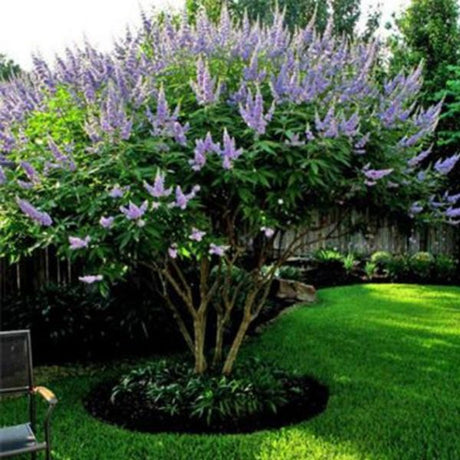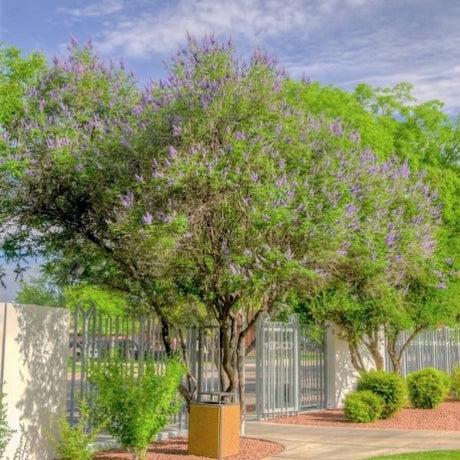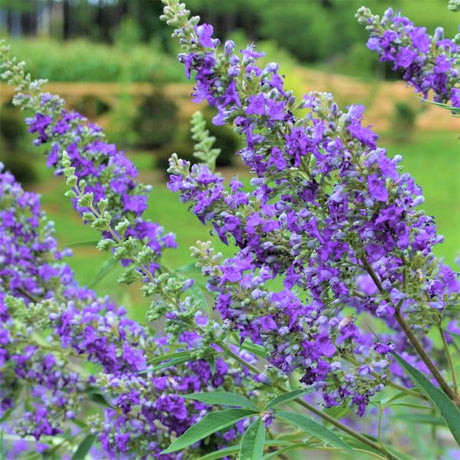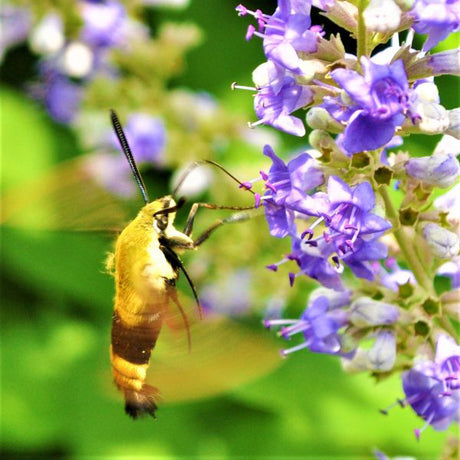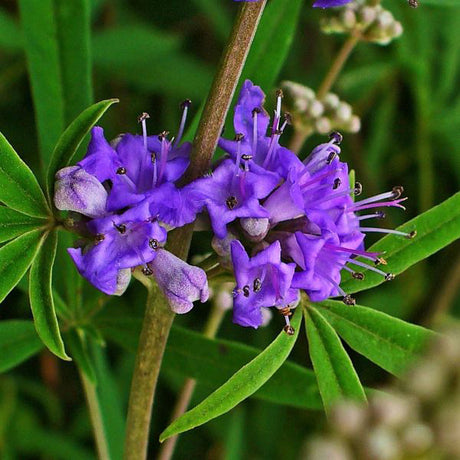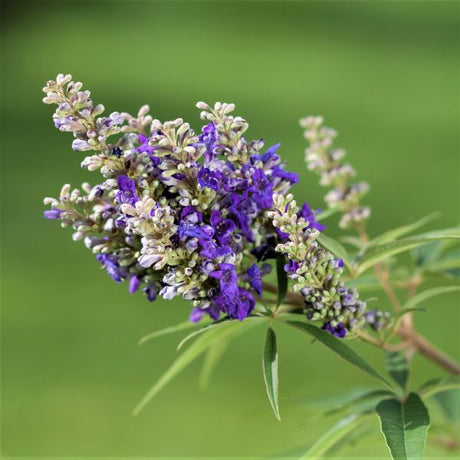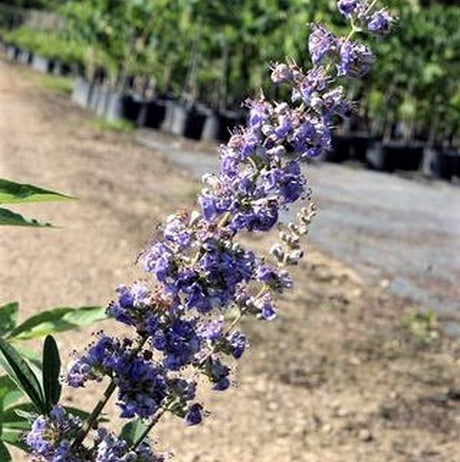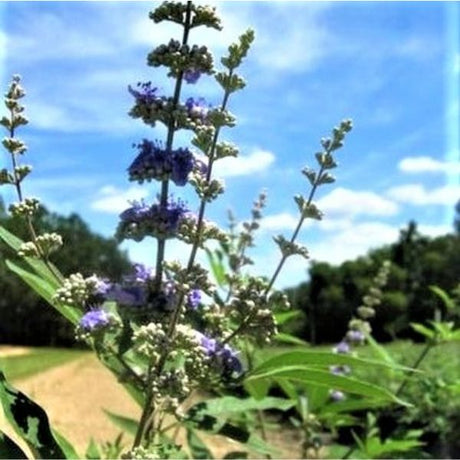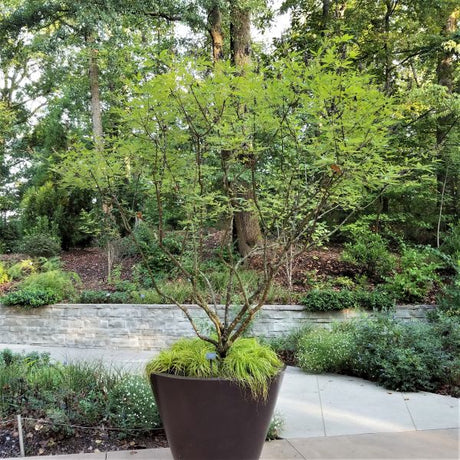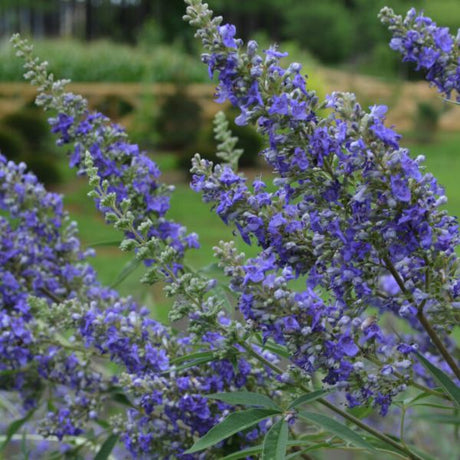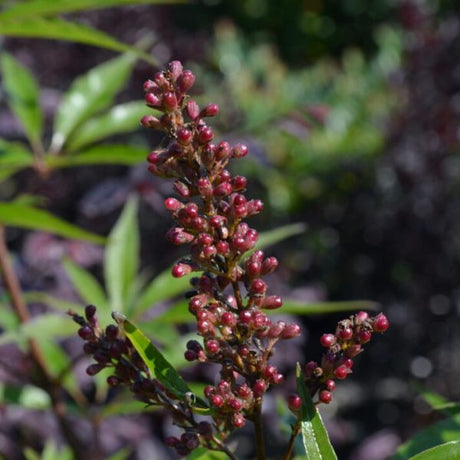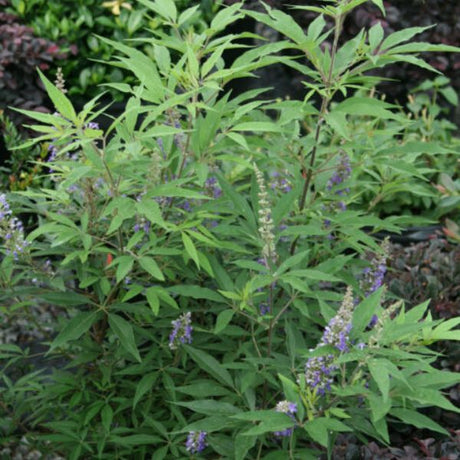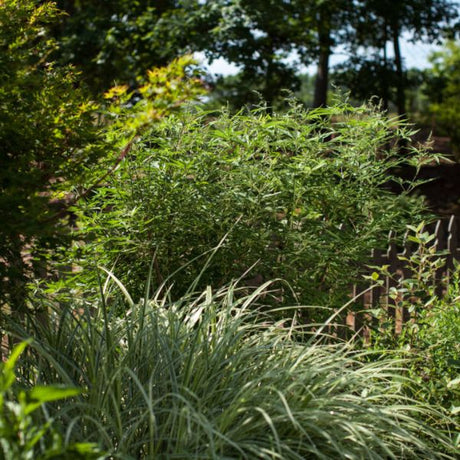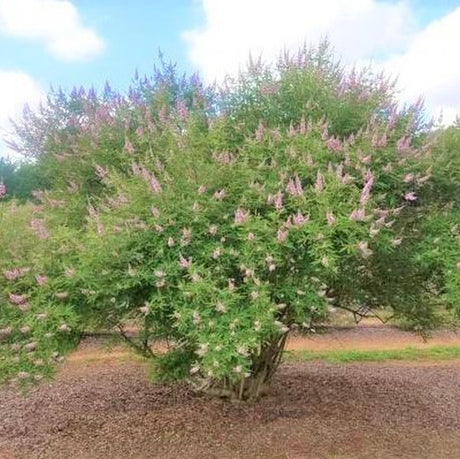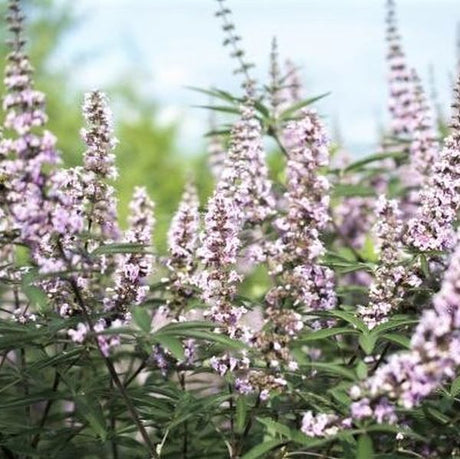- Sold out
- Sold out
Vitex agnus-castus 'PIIVAC-Il'
Regular price From $5992Unit price /Unavailable - Sold outUp to 6% off
Vitex agnus-castus 'Shoal Creek'
Regular price From $000Unit price /Unavailable - Sold out
Vitex Agnus-Castus 'PIIVAC-I'
Regular price From $5993Unit price /Unavailable - Sold out
Vitex agnus-castus 'Bailtextwo'
Regular price From $4468Unit price /Unavailable
Drought-Tolerant Chaste Trees - Summer's Best Blooming Tree

Looking for a low-maintenance flowering tree that thrives in hot, dry conditions? Chaste Trees (Vitex agnus-castus), also called Texas Lilac, deliver months of fragrant blooms while standing strong against drought and deer. These powerhouse plants are the perfect alternative to high-maintenance Crape Myrtles and invasive Butterfly Bushes!
Native to southern Europe and western Asia, these fast-growing ornamental trees feature aromatic gray-green foliage that contrasts beautifully with showy spikes of fragrant flowers. Choose from stunning purple-blue varieties like Shoal Creek, compact options like Blue Puffball™, or elegant white and pink flowering selections.
Why Chaste Trees Outperform Other Summer Bloomers
Deer Resistant: Unlike many flowering trees, deer leave Vitex alone. That means your blooms stay beautiful all season without constant protection or worry.
Drought Tolerant When Established: Once your Chaste Tree settles in, it thrives in xeric conditions and handles summer heat like a champion. Perfect for water-wise landscapes and hot climate gardens.
Pollinator Powerhouse: The fragrant blooms attract bees, butterflies, and hummingbirds all summer long. Each terminal flower spike stays colorful from June through September, with potential fall reblooms in warmer zones.
Fast Growing & Low Maintenance: Chaste Trees can add 4-7 feet per season and require minimal care once established. They're disease and pest-resistant, making them ideal for beginner gardeners and busy homeowners alike.
Heat Loving: While crape myrtles struggle in extreme heat and butterfly bushes can become invasive, Chaste Trees thrive in hot climates without spreading aggressively. They're the smarter choice for southern and western landscapes.
Understanding Tree Forms: Single-Stem, Multi-Stem & Shrub

We offer Chaste Trees in three distinct forms. The difference is purely aesthetic, so choose based on your landscape style!
- Single-Stem Tree Form: One trunk emerges from the ground and branches near the top, creating the classic tree silhouette. Perfect for providing dappled shade or as a focal point specimen. Typically reaches 10-15 feet tall.
- Multi-Stem Tree Form: Three or more stems create an elegant clumping form with branches weaving together for an airy, graceful look. Great for naturalistic gardens or as screening plants.
- Shrub Form: Multiple stems branch close to the ground, creating a bushy profile that's ideal for hedges, borders, or foundation plantings. Generally stays more compact than tree forms.
You can also shape your Chaste Tree through strategic pruning. Since Vitex blooms on new wood, annual spring pruning actually encourages more flowers!
Popular Chaste Tree Varieties at Nature Hills
Shoal Creek Chaste Tree is our most popular cultivar, featuring deep purple-blue blooms on a vigorous grower that reaches 12-15 feet. Perfect for creating summer shade with a spectacular floral display.
Blue Diddley® Chaste Tree is a compact dwarf selection (3-6 feet tall) that's cold hardy to zone 5. Ideal for smaller gardens, containers, or mixed borders where you need big color in a petite package.
Blue Puffball™ Chaste Tree is the smallest variety at just 3-4 feet, forming a perfect ball shape covered in sky-blue flower spikes. Use it as a garden border, in pots flanking your front door, or as a blue-flowering accent.
Rock Steady® Chaste Tree boasts the longest bloom period, flowering 6-16 weeks longer than other varieties! This medium-sized selection (8-12 feet) keeps your landscape colorful from early summer well into fall.
Pink Pinnacle™ Chaste Tree offers romantic pink flowers instead of the traditional blue-purple. Growing 10-12 feet tall, it makes a stunning hedge or privacy screen with softer color tones.
Crème de la Crème™ White Chaste Tree provides elegant white blooms that brighten shady corners and create sophisticated combinations. Pair it with blue-flowering varieties for stunning contrast in your landscape design.
Landscape Uses for Chaste Trees
- Pollinator Gardens: Create a bee and butterfly haven with fragrant, nectar-rich blooms
- Water-Wise Landscapes: Perfect for xeriscaping and drought-prone regions
- Deer-Resistant Borders: Protect your property with beautiful plantings deer won't touch
- Summer Shade Trees: Fast-growing canopy provides relief from hot sun
- Cut Flower Gardens: Long-lasting blooms for fresh arrangements
- Foundation Plantings: Soften building corners with graceful form
- Mixed Borders: Add vertical interest and summer color
- Specimen Trees: Stand-alone focal points for front yards
Hardiness Zones & Growing Conditions
Chaste Trees thrive in USDA hardiness zones 5-9. In zones 5-6, the top growth may die back during harsh winters, but the plant returns vigorously from the roots each spring, blooming on new growth by midsummer. In zones 7-9, Chaste Trees remain more evergreen and develop into larger specimens over time.
Ideal Growing Conditions:
- Sunlight: Full sun (6-8 hours minimum) for best flowering
- Soil: Well-drained soil is essential. Tolerates everything from alkaline to slightly acidic, poor soil to rich garden beds
- Water: Moderate moisture during establishment (first 1-2 years), then drought-tolerant
- Spacing: 8-15 feet apart, depending on variety and desired effect
- Heat Tolerance: Excellent. Thrives in hot, sunny locations where other flowering trees struggle
Chaste Tree Care & Maintenance
Watering: Provide regular water during the first growing season to establish deep roots. Once established, Chaste Trees are remarkably drought-tolerant. Water at the base of the plant to prevent leaf spot issues.
Mulching: Apply 3-4 inches of mulch around the root zone, keeping it a few inches away from the trunk. This conserves moisture, moderates soil temperature, and suppresses weeds.
Fertilizing: Chaste Trees aren't heavy feeders. A light application of balanced fertilizer in early spring is sufficient for most landscapes.
Pruning Chaste Trees for Maximum Blooms
One of the best features of Vitex is that it blooms on new wood, meaning you can prune heavily without sacrificing flowers. In fact, strategic pruning encourages more blooms!
Annual Pruning (Late Winter/Early Spring): Before new growth emerges, you can cut back up to one-third of the canopy height. This keeps the plant sized appropriately for your space and promotes bushier growth with more flower spikes.
Deadheading: Clip spent flower spikes throughout summer to encourage reblooming and maintain a tidy appearance. This simple task extends your floral display well into fall.
Shaping: In early spring, remove any dead, damaged, or crossing branches. You can also selectively prune to achieve your desired form, whether that's a single-trunk tree or a multi-stemmed shrub.
Order Your Chaste Trees from Nature Hills Today!
Whether you're creating a drought-tolerant landscape, building a pollinator paradise, or simply want months of fragrant blooms without the maintenance headaches, Chaste Trees deliver. With varieties sized for every garden and colors to match any design, there's a perfect Vitex waiting for your landscape.
Shop our complete selection of Chaste Trees for sale at NatureHills.com and enjoy healthy, professionally-grown plants delivered right to your door. Plus, our experts are always here to help you choose the perfect variety for your growing conditions!
FAQ's for Buying Chaste Trees Online
When is the best time to plant Chaste Trees?
When is the best time to plant Chaste Trees?
The best time to plant Chaste Trees is in early spring or fall when the temperatures are mild, giving the roots plenty of time to establish before the stress of summer heat or winter cold.
Do Chaste Trees need full sun to thrive?
Do Chaste Trees need full sun to thrive?
Yes, Chaste Trees thrive in full sun and require at least six hours of direct sunlight daily to produce their vibrant flowers and maintain a healthy, open growth habit.
How often should I water my Chaste Tree?
How often should I water my Chaste Tree?
Chaste Trees prefer moderate watering, especially during their first growing season. Once established, they become drought-tolerant but benefit from deep, infrequent watering during extended dry periods.
Can Chaste Trees be pruned to maintain a smaller size?
Can Chaste Trees be pruned to maintain a smaller size?
Yes, Chaste Trees bloom on new wood and can be pruned heavily in early spring to control height, shape the canopy, and encourage fuller flowering.
Are Chaste Trees good for pollinators and wildlife gardens?
Are Chaste Trees good for pollinators and wildlife gardens?
Absolutely! Chaste Trees are beloved by bees, butterflies, and hummingbirds, providing abundant nectar and making them a fantastic choice for pollinator-friendly and wildlife-supporting landscapes.

